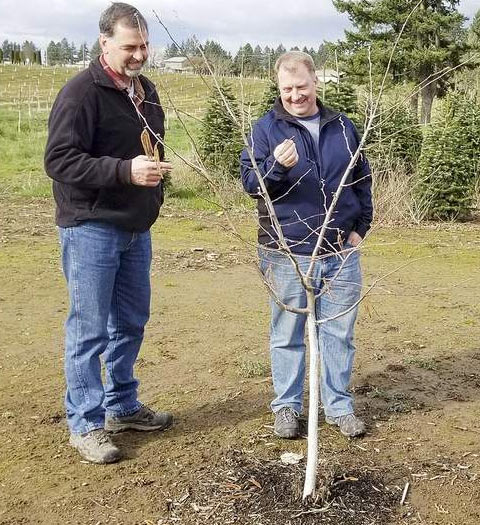Willamette Valley farmers make switch to hazelnuts
Mast-Roth Farms has planted 30 acres of hazelnuts annually for the past six years.

When the last Christmas tree falls, Gerald Mast and Jerry Roth of Mast-Roth Farms hope their young hazelnut orchards will pick up the slack.
Five years ago, after a glut in the market, the Monitor-Molalla area farmers stopped planting Christmas trees and started putting in hazelnut trees.
Mast’s father-in-law, Don Roth, began planting Christmas trees about 40 years ago and Mast joined him five years later. Since then Roth’s son Jerry came in and the two now run the farm.
“Labor was also one of the biggest factors for the change; we can do the hazelnuts with just a few people,” Gerald Mast said.
The farm is down to 20-30 acres of Christmas trees from its peak of 400 acres.
“All the Christmas trees are off the land that we own but there are a few pieces of leased ground that still have them,” Mast said. “The last couple years the Christmas tree market has been very good, which has been helpful as we establish our hazelnut orchards.”
They’re nearly finished planting hazelnuts. They’re in their sixth year of planting about 30 acres a year and hope to end up with about 185 acres in nuts. Two years ago, they began harvesting nuts from 4-year-old trees and this past year harvested from 4- and 5-year-old trees.
It was a low production year for everybody, but Mast and Roth were pleased at their yield, gathering 600 pounds per acre on the 4-year-old trees and a little more than 1,500 pounds on the 5-year-olds. Selling off some of their Christmas tree equipment has helped them in purchasing a whole new set of machinery for their new crop.
Along the way, they’ve had a lot of help. They follow the program set out by Valley Ag, a division of Wilco, and Wilbur-Ellis provides recommendations.
“We’ve also learned a lot from other growers,” Mast said. “This industry is different than others; growers seem to share information freely; it’s very refreshing.”
Lately, some growers have been double-planting for higher, earlier production. Trees go in 10-by-20 feet apart and then when they start to grow together every other tree is taken out and the remaining trees end up 20-by-20 feet apart.
“We’re going 18-by-12 because we figure we can get a few more years off the trees before we need to take them out,” Mast said.
While the Willamette Valley produces about 99 percent of the U.S. supply, it only produces 4-5 percent of the world’s hazelnuts.
“We haven’t hit the domestic market like we could,” Mast said. “When the supply is there for a year-round market, talk is there’s going to be a problem with overproduction if we don’t build up our domestic market.”
In addition to the unpredictable market and labor costs associated with Christmas trees, Mast is just ready to stop.
“I’ve done it long enough and the harvest is quite brutal,” he said, “It can be very wet and muddy and you can’t stop; you’ve just got to keep going.”

